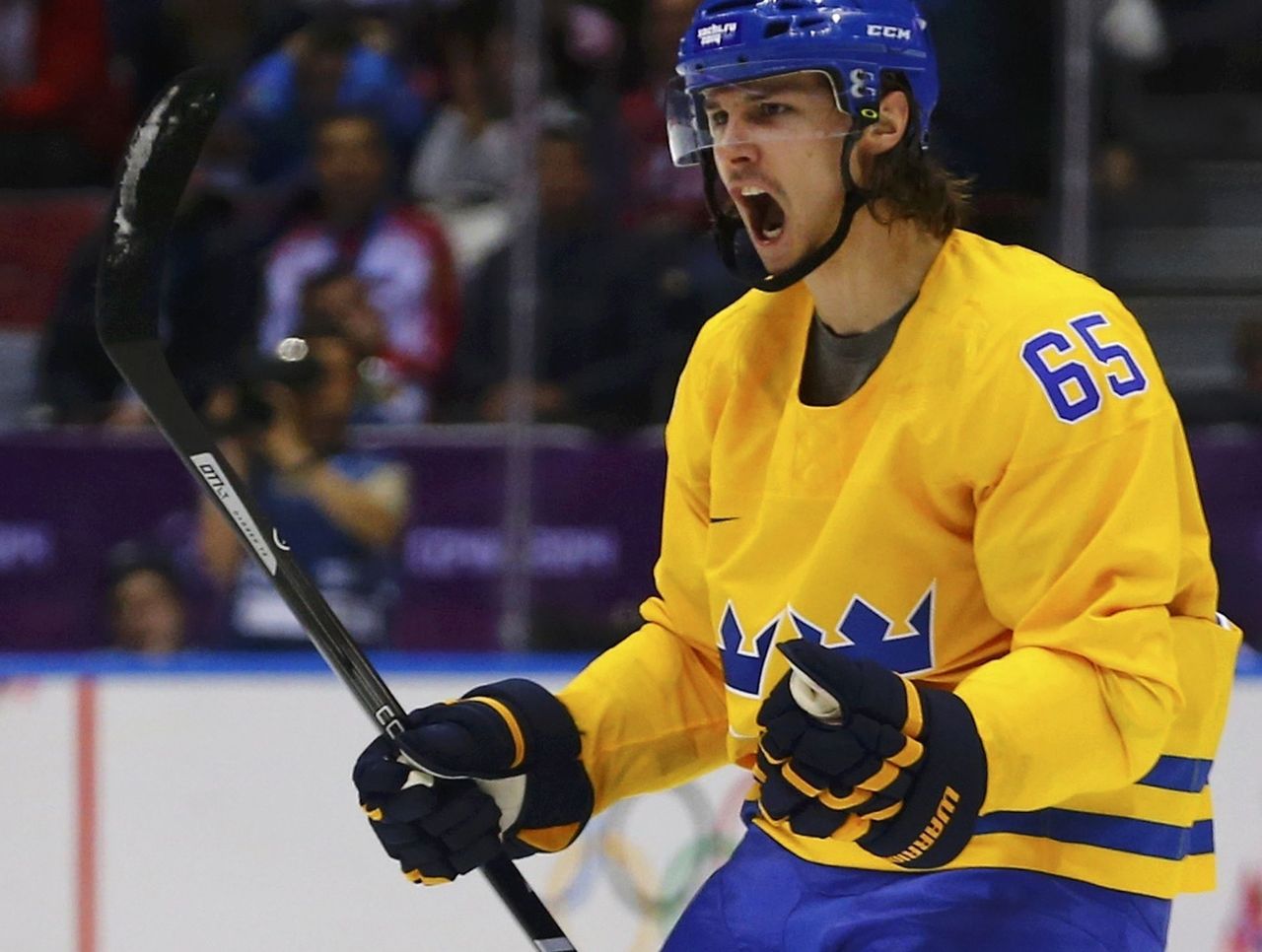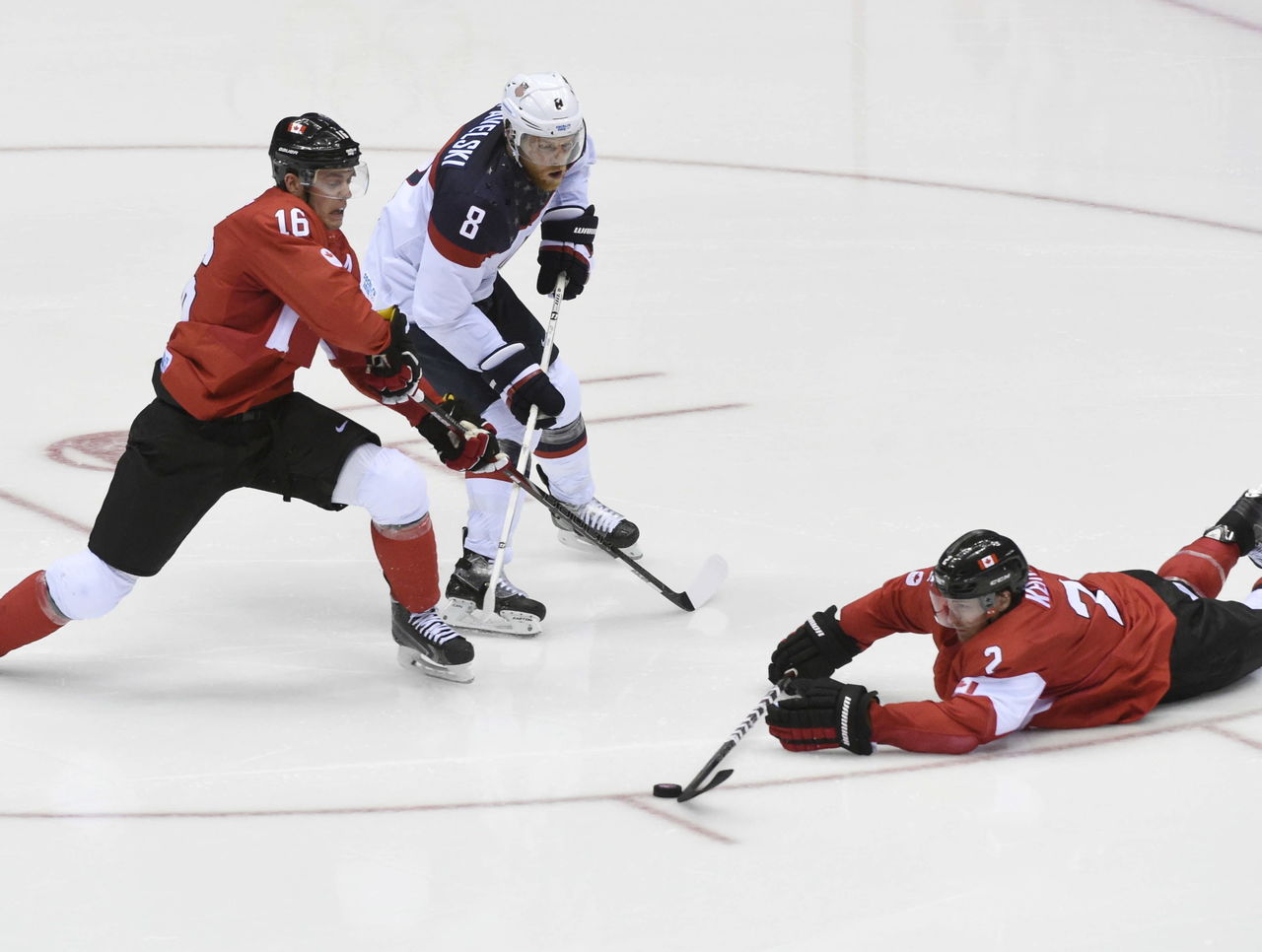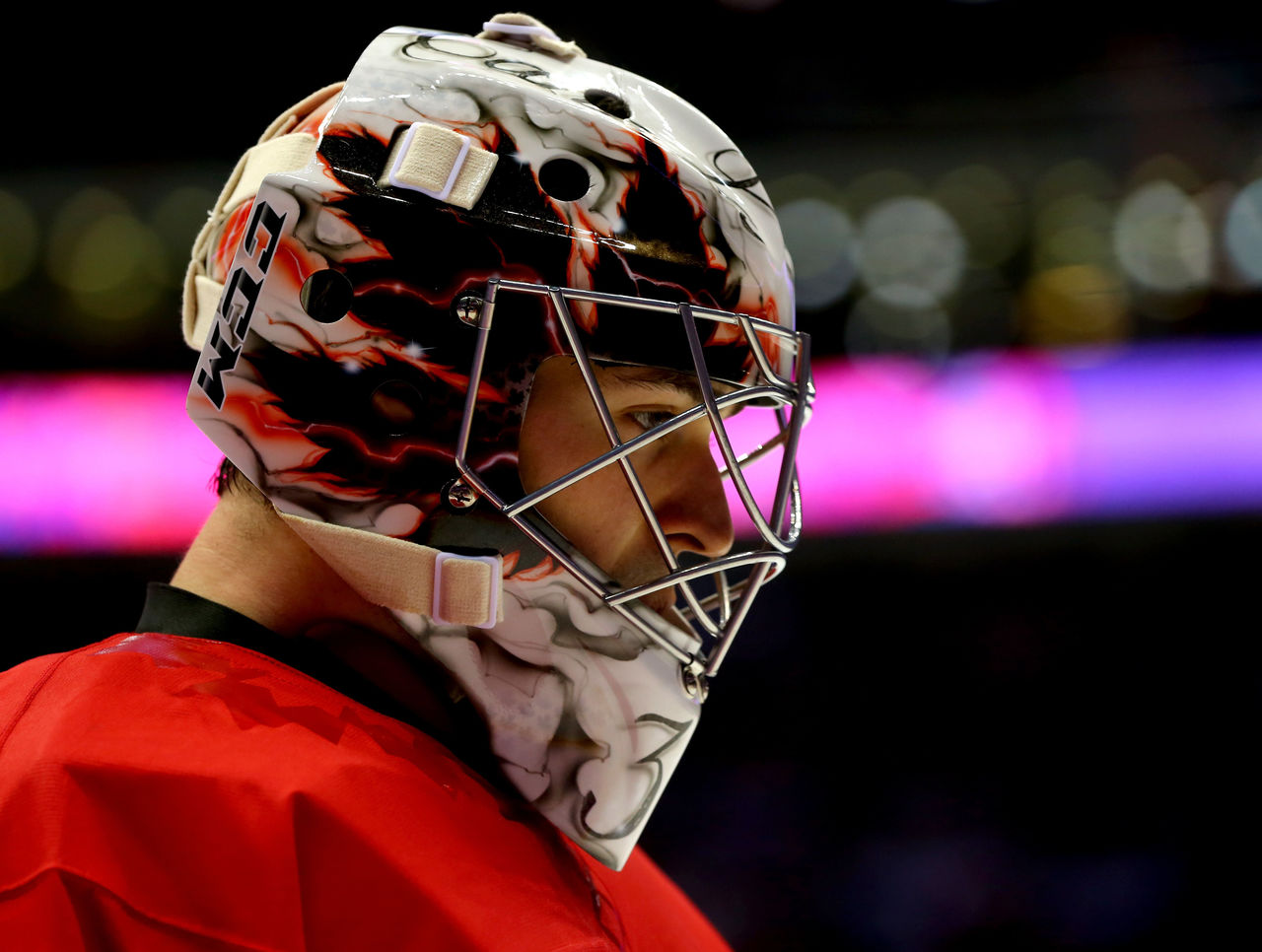Gold medal game preview: Sweden vs. Canada by the numbers
20 year ago in Lillehammer, Sweden's and Canada's men's ice hockey teams faced off in an Olympic gold medal final. In that game, Sweden's Peter Forsberg memorably deked out Canadian netminder Corey Hirsh with a legendary move in the shootout, leading Sweden to their first ever gold medal finish in men's hockey.
Since Canada and Sweden met two decades ago, no other country has won international hockey's ultimate prize. Well, unless they brought an in-his-prime Dominik Hasek to the tournament...
Now, two juggernauts of international hockey - one the reigning world champions, and the other the reigning Olympic gold medallists - will face each other in the men's hockey gold medal game on Sunday.
How might we expect the game to play out?
Skaters

All tournament long we've recorded "scoring chances" for every single men's hockey game played at the Sochi 2014 Winter Olympic games. Here's how we've defined a scoring chance:
"A scoring chance is counted any time a team directs a shot cleanly on-net from within the area where the most goals go in - between and below the circles. You can get a handle on what the scoring chance area looks like here. Shots on goal and misses are counted, but blocked shots are not (unless the player who blocks the shot is “acting like a goaltender”). Generally speaking, we are more generous with the boundaries of the scoring chance area if there is dangerous puck movement immediately preceding the scoring chance, or if the scoring chance is screened. Tip shots are only counted if they're obvious sets."
In addition to tracking scoring chances for teams, we've counted up individual scoring chance contributions. A "chance taken" is credited to the shooter of any scoring chance. A "chance created" is something like a "results independent basketball assist" - it's credited to whomever sets up a scoring chance, so long as the pass led directly to the counted chance.
Alright, so we have our definitions.
Here are the individual scoring chance contributions from Swedish skaters so far at the Olympic tournament:
| Sweden | Taken | Created | Total |
|---|---|---|---|
| Loui Eriksson | 11 | 7 | 18 |
| Daniel Sedin | 11 | 6 | 17 |
| Erik Karlsson | 8 | 6 | 14 |
| Nicklas Backstrom | 4 | 10 | 14 |
| Daniel Alfredsson | 9 | 4 | 13 |
| Patrik Berglund | 10 | 2 | 12 |
| Alex Steen | 9 | 3 | 12 |
| Carl Hagelin | 6 | 1 | 7 |
| Jimmie Ericsson | 5 | 1 | 6 |
| Marcus Johansson | 4 | 0 | 4 |
| Henrik Zetterberg | 1 | 3 | 4 |
| Jakob Silfverberg | 3 | 0 | 3 |
| Gabriel Landeskog | 2 | 1 | 3 |
| Jonathan Ericsson | 2 | 1 | 3 |
| Alex Edler | 2 | 1 | 3 |
| Gustav Nyquist | 1 | 2 | 3 |
| Oliver Ekman-Larsson | 1 | 2 | 3 |
| Marcus Kruger | 0 | 2 | 2 |
| Johnny Oduya | 1 | 0 | 1 |
| Niklas Hjalmarsson | 1 | 0 | 1 |
| Niklas Kronwall | 0 | 1 | 1 |
After a slow start to the tournament the forward line of Nicklas Backstrom, Loui Eriksson and Daniel Sedin have dominated the opposition over the past three games. That's the same line - albeit centered by Nicklas Backstrom instead of Henrik Sedin (who is injured and was unable to participate in the Olympics) - that led Sweden at the World Championships this past May.
As good as that line has been, however, the key to the Swedish attack is leading scorer Erik Karlsson. The slick Swedish defender is contributing to nearly three scoring chances per game at the tournament thus far, a completely absurd number for a defenseman.
Karlsson is a unique offensive force, and the focal point of the Swedish offensive attack.
Here are the individual scoring chance contributions from the Canadian skaters:
| Canada | Taken | Created | Total |
|---|---|---|---|
| Sidney Crosby | 13 | 11 | 24 |
| Jeff Carter | 17 | 3 | 20 |
| Corey Perry | 11 | 4 | 15 |
| Jonathan Toews | 8 | 7 | 15 |
| Jamie Benn | 10 | 2 | 12 |
| Chris Kunitz | 9 | 2 | 11 |
| Ryan Getzlaf | 2 | 8 | 10 |
| John Tavares | 6 | 3 | 9 |
| Drew Doughty | 6 | 2 | 8 |
| Patrick Sharp | 4 | 4 | 8 |
| Alex Pietrangelo | 6 | 1 | 7 |
| Patrick Marleau | 5 | 2 | 7 |
| Rick Nash | 5 | 2 | 7 |
| Shea Weber | 4 | 3 | 7 |
| Patrice Bergeron | 2 | 5 | 7 |
| Duncan Keith | 1 | 4 | 5 |
| Matt Duchene | 4 | 0 | 4 |
| Martin St. Louis | 3 | 1 | 4 |
| M.E. Vlasic | 2 | 2 | 4 |
| Jay Bouwmeester | 1 | 1 | 2 |
| P.K. Subban | 0 | 1 | 1 |
Though Sidney Crosby hasn't been enormously productive offensively at the Olympic tournament so far, he's generated chances at an outrageous rate. We would say that he's due to breakout soon, but there's only one game left to play in the Olympic tournament.
Jeff Carter, meanwhile, has easily been Canada's most dangerous and prolific shooter at the tournament.
While Canada doesn't have a Karlsson-type keying the attack from the blue-line - probably because there's no one like Karlsson in hockey at the moment - one thing you might notice is that five different Canadian defenders have contributed to more than four scoring chances at the Olympics so far.
Karlsson aside, no other Swedish defender has contributed to more than three of Sweden's scoring chances in this tournament. It's fair to say that Canada has the more aggressive, active defense overall.
Both of these teams have two stellar forward lines, but at the bottom-end of the roster there's really no comparison. Canada's defensive group has been more active offensively top-to-bottom, and the Canadian depth forwards have also generated significantly more than the Tre Kronor's bottom-six forward group has at the Olympics so far.
Five-on-Five

Canada's dominant performance against Team USA in the semifinal would strongly suggest that there's no team in international hockey that can hang with the Canadian side at even-strength. Even if there was a team that could, that team is very probably not Sweden (though the story might be different if Henrik Zetterberg and Henrik Sedin were healthy).
Here's how each team has performed, by the scoring chance data, at even-strength at the Olympic tournament so far:
| EV | EV Chances For | EV Chances Against | EV CF% |
|---|---|---|---|
| Sweden | 60 | 44 | 57.7% |
| Canada | 108 | 37 | 74.5% |
In comparison with the Tre Kronor, Canada managed nearly fifty additional even-strength chances for over their five games at the Olympic tournament. They also allowed modestly fewer scoring chances against.
In short the discrepancy in the quality of Canada's five-on-five play and Sweden's is significant, and we might reasonably expect that to be the case again on Sunday.
Although as a qualifier we should add that Sweden did better at even-strength against Finland - the only common opponent both sides have faced in the tournament - in the semifinal, than Canada did in the preliminary round.
Five-on-Four

Sweden's power-play is unbelievably dangerous, and it's their big advantage over the Canadian side going into the gold medal game. The potent Tre Kronor power play has cashed in seven goals in five games at the Olympic tournament so far, converting on nearly 40 percent of their man-advantage opportunities.
Sweden's five-on-four potency shows up in our scoring chances data, where they're generating very nearly two scoring chances per two minutes of power-play ice time:
| Power play | PPGF | PP% | PP CF | PP TOI | CF/PP Opp |
|---|---|---|---|---|---|
| Sweden | 7 | 36.8% | 31 | 31: 38 | 1.96 |
| Canada | 2 | 22.2% | 12 | 17: 13 | 1.39 |
Legend
PPGF = power-play goals for
PP% = power-play percentage
PP CF = power-play chances for
PP TOI = power-play ice time
CF/PP Opp = chances for rated per two minutes of PP TOI
So the Tre Kronor have recorded five more power-play goals than Canada has at the tournament, and have 19 more power-play scoring chances through five games by our count. That's a huge number.
While some of that discrepancy can be explained by the fact that Sweden has spent a lot more time with the man-advantage at the tournament, Sweden's also generating quality looks at a far superior rate.
To wade into the personnel and schemes a bit, Sweden's power play features Karlsson as the only true defenseman on the first unit.
While Karlsson is often described as a rover by broadcasters, he operates almost exclusively on the point when Sweden's power play is set up in the offensive zone (although he is aggressive on the rush). The rest of the "first unit" features Gabriel Landeskog at the net front, Patrik Berglund in the high-slot, and Alex Steen and Daniel Alfredsson at the top of the circles.
Alfredsson is ostensibly the second defenseman in that formation, and acts as a shooting threat while Steen functions as a primary puck-handler and passer.
Daniel Sedin, Loui Eriksson and Nicklas Backstrom have been the forwards on Sweden's second power-play unit, but based on the way they've performed in the elimination round it wouldn't be a surprise if they were to replace the "first unit" outright on Sunday. In which case Sedin handles the net front, Eriksson plays in the high-slot and Backstrom becomes the primary distributor.
Canada doesn't really have a "first" and "second" unit, and power-play ice time appears to be distributed pretty evenly. There's a forward group featuring Corey Perry, Ryan Getzlaf and Jonathan Toews, and they usually play with Drew Doughty and Shea Weber at the point. A second group features forward Patrick Sharp alongside his Blackhawks teammate Duncan Keith at the point, with Jeff Carter, Sidney Crosby and Chris Kunitz upfront.
Qualitatively speaking, Sweden's power play appears to be more content to be patient. The Tre Kronor pass the puck threateningly around the zone looking to set up tip-shots and one-timers. Obviously it has worked for them so far.
Canada's power play features more movement (it's not odd to see Doughty or Sharp behind the goal line while a forward supports at the point), and the personnel tend to shoot the puck more quickly.
Four-on-Five

Both of these teams are extraordinarily good at killing penalties. It's not just that they've killed nearly 90 percent of opposition power-play opportunities at the tournament, it's also that they've limited the number of quality looks surrendered when short a man.
Here's the penalty-killing specific chance data for both teams:
| Penalty Kill | PPGA | PK% | SH CA | SH TOI | CA/PK Opp |
|---|---|---|---|---|---|
| Sweden | 2 | 89.5% | 16 | 34: 13 | 0.94 |
| Canada | 1 | 92.9% | 6 | 28: 28 | 0.42 |
Legend
PPGA = power-play goals against
PK% = penalty kill percentage
SH CA = short handed chances against
SH TOI = short handed ice time
CA/PK Opp = chances against rated per two minutes of SH TOI
The titanic struggle between Canada's outrageously good pressure penalty kill, and Sweden's extraordinarily productive and patient power play is perhaps the most fascinating sub-plot heading into Sunday's gold medal tilt.
Canada hasn't given up a power-play goal against since their first game of the tournament against Norway, and that goal was something of a fluke that deflected in off of a screening Patrick Thoresen. The Canadian penalty kill can throw both Patrice Bergeron and Jonathan Toews out for defensive zone faceoffs, making them near impossible to hem in.
Is Canada's penalty kill good enough to silence a Swedish power play that has absolutely flattened their opponents all tournament? If it is, that could prove decisive.
Goaltending

Goaltending is critical in a single game elimination tournament, but it's tough basically impossible to determine in advance whether or not a team will have an edge in goal in a single game (unless one of the teams is starting Ondrej Pavelec).
Pucks bounce in hockey. Even the best goaltenders can be victimized by a fluky, costly, untimely goal against.
Suffice it to say that both Carey Price and Henrik Lundqvist have been excellent so far in the tournament, and both sport Olympic save percentages north of .950 going into the gold medal showdown.
Lundqvist has the deeper track record of success, he has more experience on the international sized ice surface, and he's posted an elite save percentage in nearly every season of his NHL career. Price hasn't posted an elite save percentage consistently in the NHL, but of the two starters he's having the better season this year.
It's pretty much a wash, but Sweden maybe has a modest edge between the pipes.
Summary
Canada should be considered the favorite going into Sunday's gold medal tilt. Certainly the betting odds reflect such a conclusion (on-line sports book Bodog.ca has the Canadians favored 2/1 over Sweden).
Canada probably has a big edge at even-strength, largely because their depth is superior at every position. Sweden has arguably the better goaltender and absolutely the better power play, but Canada's penalty kill could - theoretically - be the perfect antidote.
In a single-game elimination tournament any game is just as likely to be decided by execution and the bounces as it is by the relative quality of the teams contesting it. If Canada can (finally) finish some of their multitude of scoring chances, they'll be able to put away a formidable, dangerous Swedish side on Sunday. The Tre Kronor, meanwhile, will need their power play to come through against a stellar Canadian penalty kill, and will require Lundqvist to be excellent.
But it's just one game. Anything can happen.
HEADLINES
- Atkins: Okamoto signing another 'significant step' for Blue Jays
- Jets GM Mougey confident in quick turnaround after 3-14 season
- Thunder figuring things out after 6-6 stretch follows 24-1 start
- Luka, Giannis still leading in 2nd All-Star voting update
- NBA Rookie of the Year rankings: Flagg vaults Knueppel for top spot